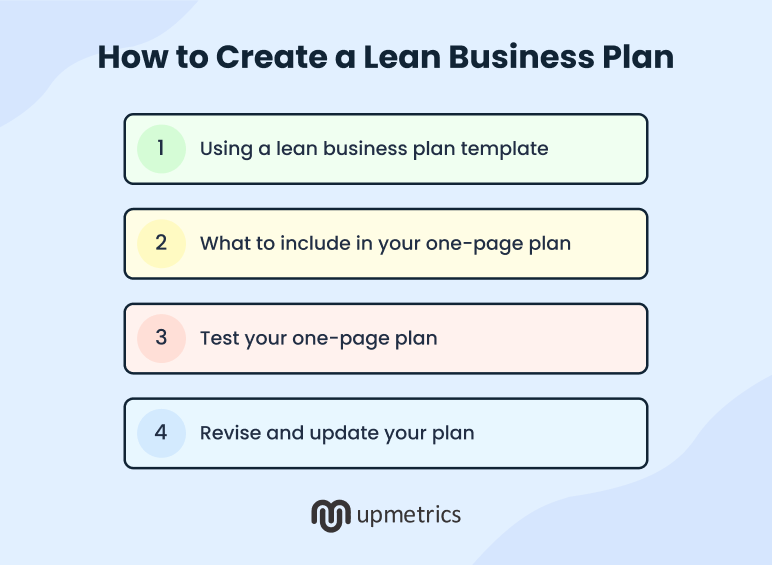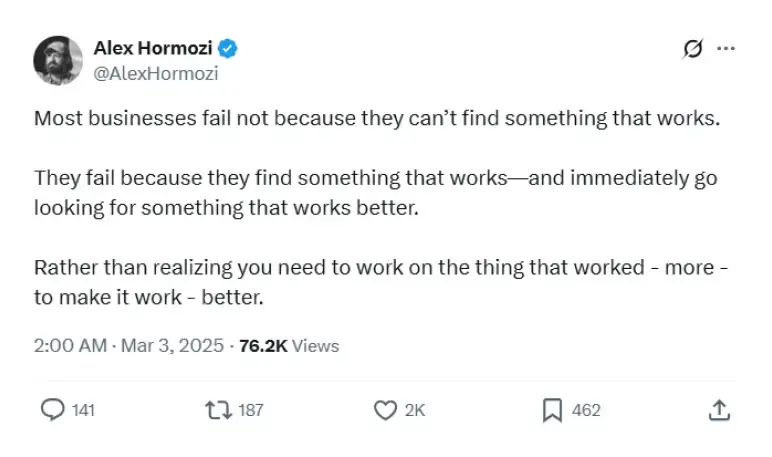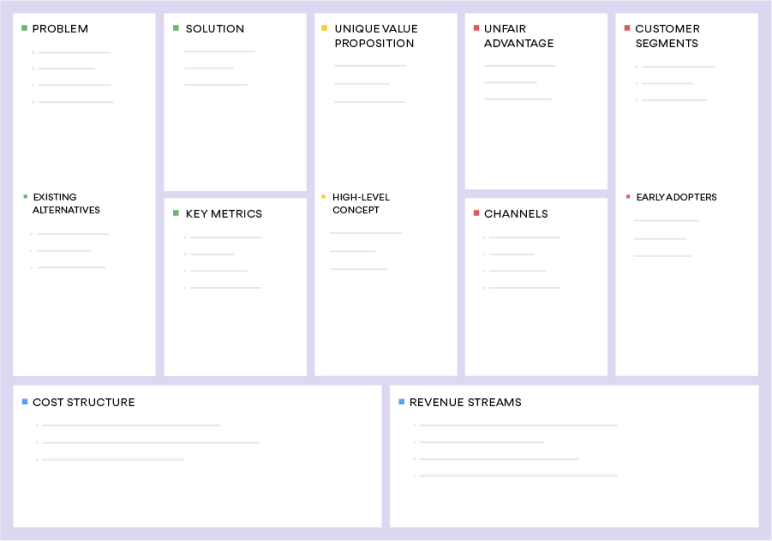Business planning has always been about the thinking process—the discipline of testing the assumptions that hold a business idea together.
But most founders I see jump to writing a 40-page business plan right from day 1.
Tell me, how do you build comprehensive strategies when you haven’t even tested if your business idea is worth pursuing? Or even validated whether the market actually needs your solution?
That’s why I encourage founders to plan lean first. Coined by Tim Berry, the founder of Palo Alto Software, this approach lets you test, learn, and refine your understanding of what actually works in the real world—at speed.
With this blog post, let me show you how you can master lean business planning and save yourself months (maybe years) of wasted effort trying to get planning right later.
What exactly is lean business planning?
Lean business planning is a strategic planning approach focused on rapid testing and iteration. Here, you treat your initial business ideas as hypotheses, validate those assumptions through continuous testing, and make quick refinements based on what you learn.
Lean planning nudges you to focus on the core aspects of your business fundamentals. That is, what your business does, who it serves, what makes it unique, and how it makes money. This very understanding gives you the foundation necessary to build a comprehensive roadmap.
Is lean planning better than traditional methods?
People often think that lean planning is a better alternative to traditional planning methods.
I would say it’s unfair and illogical to compare them.
Think of lean planning as an activity that helps you validate your assumptions. With this planning approach, you ensure that your business idea is worth chasing and there’s a market of people who actually need your solution.
Here, you put your untested assumptions about the market, target customers, business model, and pricing to test. If the assumptions prove wrong, you refine your approach, test it again, and continue until most unknowns are removed.
This process continues whether you’re in a pre-launch stage, unsure about product-market fit, or in a growth stage, testing your strategy to enter new markets.
But when you’re set to attract investors or partners for your business, you need something more insightful. Maybe a document that details market analysis, financial projections, study of competitive landscapes, and steps to implement your strategies (tactics).
That’s where traditional planning becomes essential. With traditional planning, you focus on roadmaps and a long-term picture.
So to answer your question, lean methodology isn’t a replacement to traditional planning. It’s an approach that helps you build a validated set of assumptions before you commit to strategic execution.
How to create a lean business plan (using a template)
Lean plans are hardly one page long, so writing them doesn’t require much effort. But knowing what to put in it requires a bit of understanding.
Let me show you how you can put together an actionable lean plan for your business:

Step 1: Using a lean business plan template
I have seen entrepreneurs spend weeks trying to figure out what to include in their plans. They’d research formats, study different approaches, and waste valuable time on structure instead of substance.
My cents? No need to reinvent the wheel when you can get started with a pre-built lean business plan template.
Templates tell you exactly what sections to include without overwhelming you with unnecessary details. Think of it as fill-in-the-blanks planning.
You get a structure, a set of questions, and small prompts to guide your thinking in the right direction. Just choose a template that’s been tested by thousands of businesses and use it to validate your ideas.
→ Download Now: Lean Canvas Template
Step 2: What to include in your one-page plan
More or less every template nudges you to find answers to these primary questions:
- Market strategy: What problem are you solving and for whom?
- Value proposition: What makes you different from existing solutions?
- Financial framework: How will you make money and measure success?
Let’s approach each core category with clarity:
1) Market strategy
Think of market strategy as your business GPS. It tells you where you’re going (the problem), who you’re helping (the customers), and what route you’re taking (your solution).
The problem you’re solving
There ought to be a problem you plan to solve with your business. What is it? What pain is it causing to people or society at large?
Analyze the frequency and intensity of the problem. If it’s an infrequent or low-intensity problem, you’re going to have a hard time getting customers interested in even talking to you.
Moreover, identifying the problem early helps you test if it’s urgent enough for customers to care. A lean plan isn’t about writing pages of analysis—it’s about validating whether you’re solving something people actually want solved.
Also, don’t start with a cool technology and then hunt for problems it might solve. Solutions are supposed to be built around real problems, not the other way around.
As Michael Seibel, the former Y Combinator CEO, says, “Hold the problem you’re solving tightly. Hold the customer tightly. Hold the solution you’re building loosely.”
The solution you have to offer
Now, present the solution (i.e., your products or services) to the problems you just mentioned earlier.
Don’t get too obsessed with the technology or your product. Focus on showing how your customer’s pain can be alleviated.
Again, you can just list down solutions for each problem or create a crisp paragraph to describe your solution. Remember, your solution is a hypothesis. In lean planning, you capture it briefly so you can test, refine, or pivot without wasting time perfecting details too early.
The existing alternatives in the market
Competition isn’t a bad thing, so don’t pretend you don’t have any. But don’t obsess over it either.
As WhatsApp founder Jan Koum says, “We can’t worry too much about competition. We have to worry about our product and our users. And if we spend a lot of time thinking about competition or looking at competition, we’re going to fail.”
That’s exactly what you will do at this stage.
Simply list down the businesses that are going after the same customers as you. Include your direct and indirect competitors and, if possible, note each competitor’s category advantage as well, i.e., Tesla has a category advantage in electric car manufacturers.
This vivid clarity will later help you discover opportunities for category monopolies.
Your ideal customer segments
List down different categories of customers who would be interested in your product or service, i.e., students, high-income working professionals, small young families, etc.
And if you already have some existing clientele, base assumptions about how many customers you can target in each segment.
Don’t dive much deeper into market analysis yet. But build an ideal customer profile (ICP) to validate the assumptions while running surveys. Simply list down common demographic and psychographic (interests, pain points, needs, income, buying behavior) of your ICP and move to the next section.
This helps you focus on small groups where you can run quick, cheap tests instead of chasing “everyone”.
2) Value proposition
Value proposition answers the ultimate customer question: “Why should I pick you?” It’s about positioning yourself in the market and effectively reaching your customers. Here’s what to focus on:
Your Unique Value Proposition (UVP)
What’s it about your business that makes you different from competitors? Is it your exclusive partnerships, proprietary technology, network effects, or patents that give you a better chance to succeed than anyone else in your space?
If you can’t think of any competing advantage, try completing this sentence: “Unlike other solutions, we are the only ones who…”.
It will give you an inarguably solid UVP in a single, testable statement. If customers don’t resonate with it during validation, you know where to adjust before scaling.
As Alex Hormonzi puts it,

Your marketing channels
How will your customers find out about you, and how will you convince them to buy from you?
Analyze where your customers spend most of their time and list down a few marketing channels (social media, paid ads, print ads) along with the budget you plan to spend on each channel.
Your sales strategy
How do customers actually buy from you? Through website, application, third-party platforms, physical stores, or through a mix of multiple channels?
If you are an existing business, map out the customer journey from initial contact to the point of closure. Outline their decision-making steps and the time it takes to close a deal.
3) Financial framework
Numbers don’t lie, and this section keeps you grounded in business fundamentals. In a lean plan, it’s about creating a simple financial model that guides your early decisions. Focus on these elements:
How will you generate revenue?
Do you have a sustainable model to earn revenue from your business? If so, how?
Will you charge subscription fees, take transaction cuts, or sell products directly? List down your path to profitability, and if possible, include pricing assumptions as well.
If you’re freemium, explain your conversion funnel from free to paid users.
What would be your cost structure?
How much will it take to implement a specific strategy or put together a functional business?
List down your one-time expenses and some recurring costs you will be incurring month after month.
For instance,
| One-time expense | Recurring expenses |
|---|---|
|
|
How will you evaluate the success, i.e., key metrics?
When your business starts generating revenue, or even before that, how would you know if your business is on the right path?
Pick a couple of metrics (like revenue) that you can use to evaluate business health. This could be:
- Customer acquisition cost
- Lifetime Value
- Gross profit
- Monthly recurring revenue
- Conversion rate
- Time to convert
- Number of demo signups
Don’t chase every metric initially. Choose the ones that are most important to you and ditch vanity metrics.
Build your lean business plan using Upmetrics
You can now create a focused one-page business plan using Upmetrics, without having to worry about structure or formatting.
Upmetrics’ one-page business model canvas includes all the essential fields that would guide you to think about your core assumptions systematically. And, with its AI assistant, you can easily fill the template and get your lean plan ready in minutes.

Step 3: Test your one-page plan
The very concept of lean planning relies on validation. You test the ideas and see if they align with the information on your lean plan.
If not, you make quick refinements, adjust the dependent sections, and test it again. This planning process goes on and on, even when your business starts generating revenue. That’s because the market is never steady, and your business won’t be operating under the same set of assumptions.
Turn your plan into testable sections
Every section of your lean plan contains hidden assumptions. I want you to flip each assumption into a question you can test.
For instance,
- Is the problem you have identified really a problem that needs solving urgently?
- Does your proposed solution actually solve their core problem?
- Are your target customers loyal to competitors or just settling for a lack of options?
- Is your market large enough to build a scalable, profitable business?
- Is the market oversaturated, making customer acquisition extremely expensive?
- Is your UVP compelling enough to drive actual purchase decisions?
- Do your target customers actively use the marketing channels you plan to leverage?
Here’s an example for you to follow:
Problem statement: Small businesses struggle with inventory management
Validating question: Do small business owners actually lose sleep over inventory issues?
Run quick validation experiments
Now, focus on your riskiest assumptions first and see if they stand true.
For this, talk to your potential customers. Run customer surveys. Analyze their responses and pivot if needed.
Don’t get obsessed with trying to prove your assumptions right.
That is, don’t ask if the respondent likes your business idea. Instead, ask these broad questions and allow your assumptions to be challenged:
- What are their current struggles with existing solutions?
- What would convince them to switch from their current approach?
- How much time or money does this problem currently cost them?
Replace your assumptions with facts
Your validation experiment will reveal whether your assumptions match reality.
For instance, if customers can’t quantify the problem’s impact or seem indifferent about solutions, it may mean one of these two things:
- You are chasing the wrong problem
- You are targeting the wrong audience
For such instances, go back and revise your assumptions. Iterate them till there are no major gaps between what you believe and what customers actually experience.
Step 4: Revise and update your plan
The assumptions that stand true in your validation test make it to your final plan.
But again, there’s no such thing as a final plan. Lean plans require continuous updates. Sometimes weekly, sometimes monthly, but never longer than that. And that’s the only way to make it a living document; it’s supposed to be.
So set a review cycle and track the key metrics. Keep an eye on market shifts and consumer behavior, and reflect the changes in your overall strategic approach.
There you have your lean or one-page business plan that’s grounded in factual assumptions rather than hopeful assumptions.
Turn your lean business plan into a detailed one
Lean business planning helps you move fast and learn quickly. But that doesn’t make traditional plans redundant. As I said, you will find yourself navigating between lean and traditional plans every now and then. And rightfully so.
You do need a directional roadmap to guide your long-term growth and attract funding opportunities. And, traditional plans offer just that.
That said, a lean plan isn’t wasted effort when you need something more comprehensive. It becomes your foundation for building detailed plans.
With platforms like Upmetrics, you can transform your validated one-page plan into a traditional business plan using AI assistance. This business planning app lets you switch between lean and traditional planning formats while maintaining your core business intelligence.

